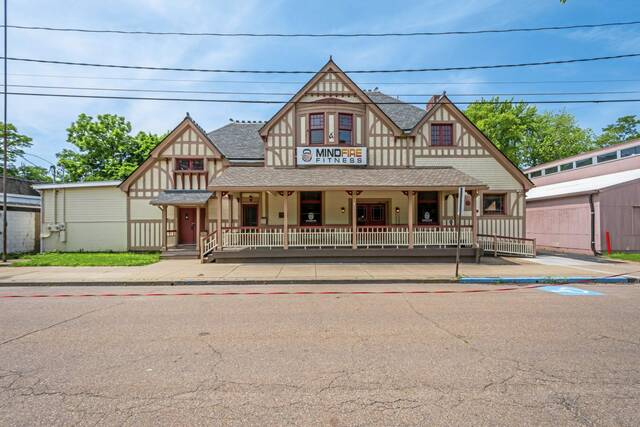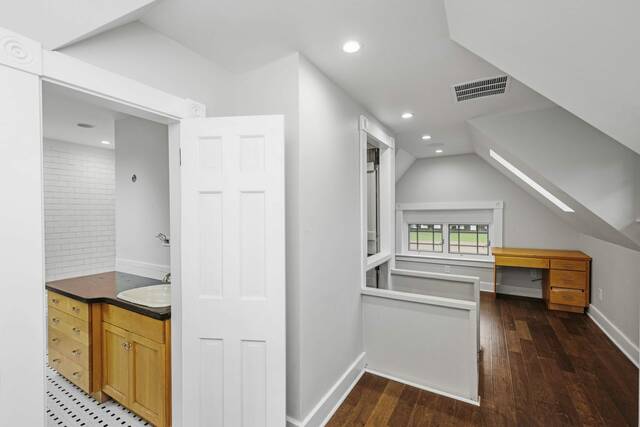Historic Sewickley train station, a hub of Black culture, on the market for $800K
A historic property in Sewickley is on the market. Built in 1887, 20 Chadwick St. is a neo-Tudor-style building that originally served as the train station in Sewickley. It later became a cultural hub for the Black community and now is a commercial building home to a CrossFit gym with a renovated apartment above.
The listing price is $800,000.
Part of the uniqueness of the property is its industrial zoning. It is geared toward a young person or couple who wants to live in the luxury apartment and have rental income from Mindfire Fitness, a CrossFit gym that occupies much of the first floor, according to real estate agent Jill Stehnach of Re/Max Select Realty.
Stehnach envisions someone who travels for work and visits Pittsburgh several times a year. She would also love to see it purchased by someone with an affinity for the building, given its history as a venue for performers like Ella Fitzgerald, Cab Calloway and Duke Ellington.
“It was the place,” Stehnach said, adding that she could see someone like Pittsburgh native Billy Porter buying the property.
“If any Black family in Sewickley or the surrounding area was having a gathering, it all happened in that building. An amazing history,” she said.
Longtime Sewickley resident Sharon Patterson can attest that the building was an epicenter for Black life in Sewickley. She held her wedding reception at the banquet hall in 1965.
In 1944, the building was purchased by Walter R. Robinson of Post 450 Sewickley Legion, an all-Black organization, Patterson said.
At Post 450, the annual “Come on Home Weekend,” a four-day event, began in early August 1967 and continued until 2013. Patterson attended the weekends for more than 20 years.
“We used to have the dance, the weekend started off with a boat ride on Thursday night, then we had a Friday night bowling tournament, Saturday was a golf outing, and that night was the banquet held at the Legion,” Patterson said. “Oh, it was beautiful. All of the families would come, you met old friends, it was a big family affair. There was dancing and music all night up and down the river.”
The weekend originally started as a joint event between the Legion and Sewickley Community Center and then was completely organized by the Legion, Patterson said. A historical account of the “Come on Home Weekend” is documented by late resident Bettie Cole in her book “Their Story: The History of Blacks/African Americans in Sewickley & Edgeworth.”
The building, which sits next to the Sewickley Community Center, has an uncommon architectural perspective, with steep gables, curved windows and a contrasting timber framework that highlights the pale stucco. There is also a rooftop deck that overlooks the train tracks and the Ohio River.
Owner and developer Monroe “Rody” Nash purchased the property in 2015. Nash is a longtime Sewickley-area resident and Leet commissioner who also owned the building next door for many years.
“I knew the owners at the Legion, and I wanted to support just to help keep the building going,” Nash said.
There is a historical landmark plaque on the building from the Pittsburgh History & Landmarks Foundation. The nice thing about the building, according to Nash, is its versatility.
“There were two parts of the property, the train station building part, and later on the banquet hall, complete with a stage, banquettes and bars, that was built on the back of it when it was given to the Legion in the late ’40s after World War II.”
The building has been moved three times and rolled down the railroad tracks. When it originally operated as a train station, it was located by the old Sewickley post office, now Sweetwater Center for the Arts, and alongside the railroad tracks. Despite the moves, the integrity of the building has stayed much the same, “and that is really cool,” Nash said.
“On the first floor was the station floor and the baggage room on the left. Then above, the station agent’s apartment and office on the second floor has always been an apartment and an office where they might watch the trains come in and do any paperwork,” he said.
Nash considers it a retro space, and he tried to maintain the way it looked back in the day.
“I just refurbished it and got it back up to speed,” he said. “I’ve been doing a lot of preserving old buildings as well as building new stuff. I get a lot of satisfaction from doing it and doing it right.”
The allure of the historical buildings is the quality of the original construction and the materials used.
“It is nice for me to keep that going or add on in a way that pays tribute to that,” he said.
Shaylah Brown is a TribLive reporter covering art, culture and communities of color. A New Jersey native, she joined the Trib in 2023. When she's not working, Shaylah dives into the worlds of art, wellness and the latest romance novels. She can be reached at sbrown@triblive.com.
Remove the ads from your TribLIVE reading experience but still support the journalists who create the content with TribLIVE Ad-Free.





